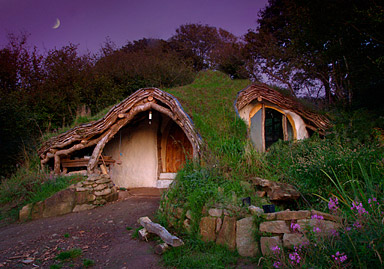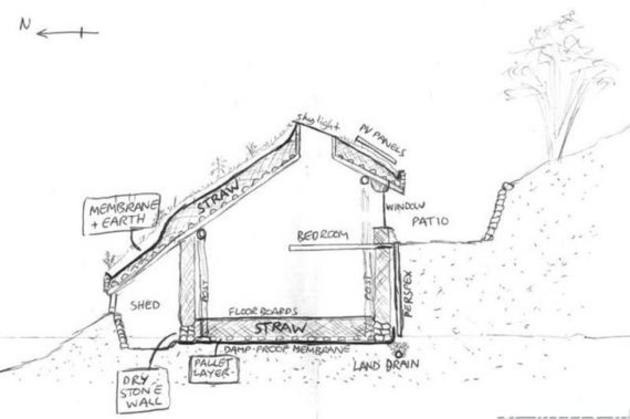good evening guys..
I will do schort.. I'm tired.. but to answer to some one..
to thing, read and write in english is still gymnastics for me, but anyway.. I like, (you imagine) this thread.. (and definitively languages) ;)
Citation de: Horseofadifferentcolor le avril 10, 2013, 04:56:13 am
My plan has been to start small, making dog houses and chicken huts agianst the side of the hill with earth bags and then trying our hand at a shelter mabey at some point.
Horseofadifferentcolor, that is an excellent approach - build storage sheds, out-buildings, animal shelters before starting your home. You will learn a lot and minimize the mistakes and impact on your own abode. Much like freesurfer says above. While building these other structures, it will give you plenty of time to think and meditate on what you want in your own home - lots of ideas will come to you for processing and consideration.
Right.. a lot of ideas and mistakes.. I think the best is making something to the human scale, not to small.
my prototype, was in 2009 a little bit for fun and change.. I thought.
I upload yesterday an other small and quick old slide show .. that you will find in the same link .. (second video)
the mistakes was:
1: not enough drainage and direct contact with the house (even having a "liner")... the best with experience is a vertical filter of graviel with (of course something making "liner" again the house and) some geotextil between the ground and the graviel.. since the drain to the floor ( and a canal on top of that is the must) that cut the capillarity, and let breathe.
2: square windows or doors.. the best is definitively arch (vault) or round form ( (and more solid)
3 use just natural material (specially in ecuador.. where we have nice rain season) the prototype was plastering outside just with lime-sand and soil, ( ands traw) using for mix the juice of the prickly pear (macerated, is a good glue and waterproof, but not enough ) and red mineral pigment on top. The balls are li-sa-so also, painted with pure hidro-lime and pigment (but, if you don't find de lime ok Marakech forget) after we put just lineseed-oil and it's ok, just renews the process two time in the year..
4 no windows opening in the bed-dome, just natural ventilation.. not enough flow of air. But sleeping under a starry sky is just

.. incredible
So not to be to much "ecolo".. to be realist! We change the top and cover with a synthetic layer and we save the "test dome"
Hi Freesurfer,
Wow! I loved watching the video - it has really inspired me, thank you for sharing!! .. and I wondered if I could send you the design when I have finished it for your advice/guidance? (before I start building it!)
first.. thank's and will be a pleasure of helping you ;)
Wow! Great video freesurfer! That was fun watching it go up that way. And very nice looking finish - and, I'm sure, very comfortable inside.
Wow! This is a fantastic video freesurfer, and congrats for your finished home ! Looks so... natural...
first thank's too.. but is not very finished, just 95 % still need 5 %.. connect electricity and "potable water", change some wooden doors ( all the wood wasn't dry ) I finished remake an other door just before, with my super assistance of 5 years old.. and wait the end of this "last" contract for cash$$$ :/ and time.. don't believe that is an inexpensive house.. I spend +'n - 52k and 9 month (I don't count me in this price, 7k for the small one )and need still the barriers of the balconies and one external staircase..
I work on.. evening .. saturdays .. when I can .. but no stress for the home... the main thing is that my family (6 pers) can eat every days..
but indeed, look very crazy and confortable inside.. soon I will show you all the "inslide job"
If you are going to bury a structure to gain the benefits of the earth heat sink, the home will be sealed from the outside air, and it is important to control air flow with the outside for fresh air (in) and exhaust air (out). Whether or not you use a fan (powered) system, you need to plan intake and exhaust ports into the structure. You will want strict control of this via dampers or gate valves for extremes of temp/humidity (cool mornings in the summer and warm afternoons in the winter). A vent fan (like a vortex fan in pvc pipe) will exchange the air quickly. You can do it passively (over a longer period) by extending the exhaust vent pipe well above (in height) the intake so that the small pressure difference drives the air flow from in to out.
You can consider a filter on the input to stop particulates in the air. A fan works much better and can be easily and cheaply powered by a 12V battery. Removing the filter will allow the passive approach to work as a backup so long as you get the exhaust pipe outlet well above the intake (or have the option to do so).
you know something about provencal or canadian well? Can to be very interesting with an underground house. ( and with an Ice age too

)
make your research, all the links I have are in french (puits provençale) .. nice thing..
well, not very short.. (for me)
I hope everything is comprehensible..
good night everyone.

r




 .. incredible
.. incredible )
) r
r